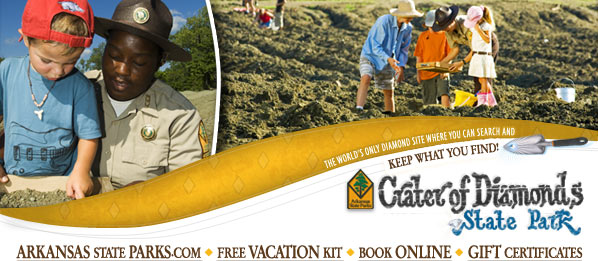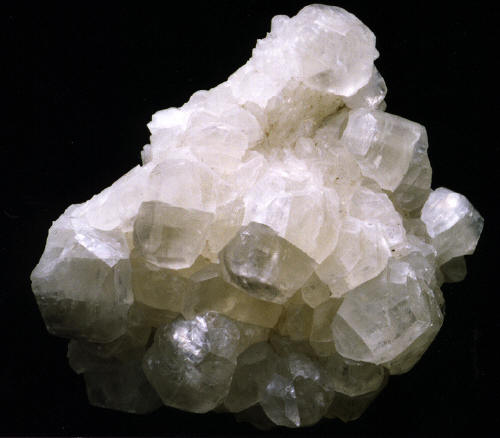
|
Calcite: A versatile and valuable mineral By Margi Jenks All of the visitors to the Crater of Diamonds State Park find calcite crystals. So, the following information will tell you a little bit more about this interesting and useful little crystal. The diamond mine contains lots of small calcite crystals for two reasons. First, the lamproite lava and ash that erupted from the Crater volcano contained between 7% and 10% calcium. This amount is the third highest percentage of an element after silica (30-35%) and magnesium (20-25%). Second, calcium is extremely soluble in water, especially hot water. When the hot water cools calcite crystals, made of calcium and carbon dioxide, easily form in any cracks in the volcanic ash and lava. Today, out on the diamond search area we often find lamproite ash pieces containing numerous calcite veins. When the ash weathers, the calcite crystals are released into the dirt that our visitors search for diamonds. Finally, the milky white calcite crystals are heavy enough to end up in the heavy concentrates, which visitors produce using the wet sluicing mining method.
It is rare, however, for visitors to find big calcite crystals. That is because calcite is a fairly soft mineral, with a Mohs scale hardness of only 3. This property means that calcite crystals can be easily broken or scratched with anything metal, like a pocket knife, tweezers, or car keys. As we identify visitors’ finds, we use this simple scratch test to sort the calcite crystals from the quartz crystals and diamonds. Another simple test for calcite is to scratch a white powder from a crystal and then add a drop of acid, particularly hydrochloric or muriatic acid. The acid breaks down the bond between the calcium and the carbon dioxide. The carbon dioxide then bubbles away, or fizzes. Calcite is the second most common mineral on the Earth’s surface. Two common rocks that are made of calcite are limestone and marble. Because many animals in the ocean use calcite to make their shells, ocean fossils are preserved in limestone rocks. Limestone can also be formed by the direct precipitation of calcite crystals out of the ocean water, which naturally contains a high percentage of dissolved calcium. We use calcite or “lime” in an amazing number of products. Calcite is the hardener in concrete and cement. It makes up chalk, whitewash, the scouring agent in scouring powder, and is the antacid part of Tums and Rolaids. We feed calcite to chickens and cows so they can produce eggshells and calcium rich milk. Finally, we use calcite in many manufacturing processes including making steel. The mining and production of calcite is big business, with over 19.3 million tons produced in the United States in 2011 with a value of $2.2 billion. China produces the most calcite of any country, with 200 million tons each year. We obviously don’t have enough calcite crystals at the diamond mine to be valuable. However, if you find large or nicely faceted calcite crystals, they make excellent souvenirs. Search area last plowed: July 18, 2012; Most recent significant rainstorms: July 26, 2012, 1.7 inches Total diamonds found in 2012: 302 Diamonds registered for July 22 - July 28, 2012 (100 points = 1 carat): July 22 - Rick Tillery, Booneville, AR, 5 pt. white; Mark & Susan Parkhill, Harker Heights, TX, 10 pt. white; Timothy Gray, Royal, AR, 7 pt. white July 23 - Ray Szoszorek, Erie, PA, 17 pt. yellow July 24 - Andrew Christiansen, Indianapolis, IN, 2 pt. yellow, 2 pt. yellow July 25 - James Patton, New York City, NY, 23 pt. white July 26 - No diamonds were registered July 27 - Houston Richardson, Prescott, AR, 12 pt. yellow |

209 State Park Road
Murfreesboro, AR 71958
Email: craterofdiamonds@arkansas.com
Phone: (870) 285-3113
You are currently subscribed to the Crater of Diamonds State Park enewsletter as: &*TO;.
To unsubscribe, go to http://diamondsstatepark.xyz/newsletter/ and click the "Unsubscribe" button.

